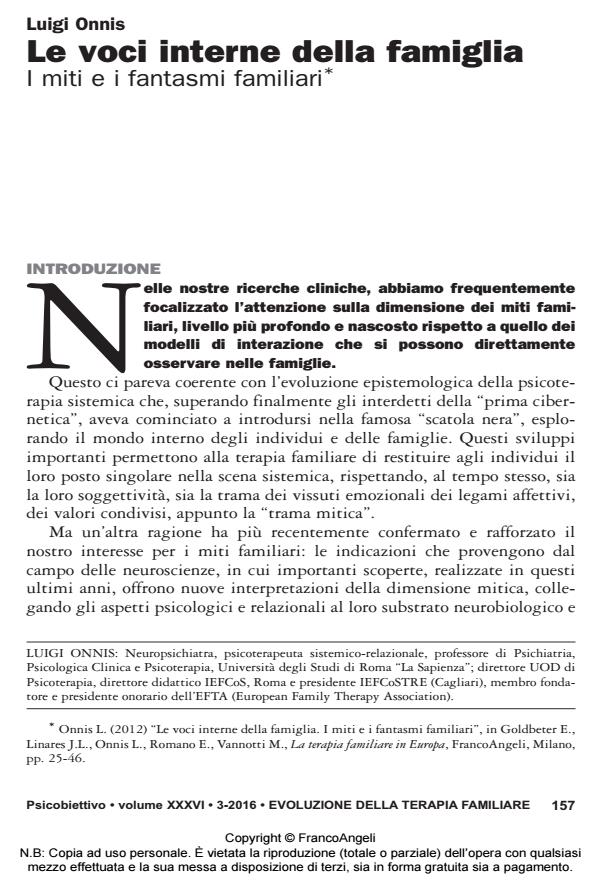Internal family voices. Family myths and ghosts
Journal title PSICOBIETTIVO
Author/s Luigi Onnis
Publishing Year 2016 Issue 2016/3 Language Italian
Pages 24 P. 157-180 File size 137 KB
DOI 10.3280/PSOB2016-003010
DOI is like a bar code for intellectual property: to have more infomation
click here
Below, you can see the article first page
If you want to buy this article in PDF format, you can do it, following the instructions to buy download credits

FrancoAngeli is member of Publishers International Linking Association, Inc (PILA), a not-for-profit association which run the CrossRef service enabling links to and from online scholarly content.
This work, in line with the evolution of the epistemological systemic psychotherapy focuses the attention on the dimension of family myths, the deepest and hidden level more than the one of the interaction models which can be directly observed in families. This legendary level collects access of family therapy, following the first cybernetic, at the deepest level of the individual’s inner world and their families, the so-called "black box". In addition, the same legendary level is found to be current thanks to the multiple interconnections with the field of neuroscience, linking psychological and relational aspects with the neurobiological substrate. Finally, it is highlighted the usefulness of the analogue language in psychotherapy through the technique of "Sculptures of Family Time".
Keywords: Family Myths; Implicit Relational Knowing; Analog Storytelling; Mirror Neurons; Sculptures of Family Time
- Anzieu D. (1975) Le groupe et l’inconscient, Dunod, Paris
- Bateson G. (1972) Steps to an ecology of mind, Ballantine, New York
- Caillè P. (1985) Famille et thérapeutes, ESF, Paris (trad. it.: Famiglie e terapeuti, NIS, Roma, 1990)
- Caillè P. (1991) Un et un font trois: le couple revelé à lui même, ESF, Paris (trad. it.: Uno e uno fanno tre, Armando Roma, 2007)
- Caillè P., Rey Y. (1994) Les objets flottants, ESF, Paris (trad. it.: Gli oggetti fluttuanti, Armando, Roma, 2005)
- Damasio A. (1995) L’errore di Cartesio: le ragioni delle emozioni, Adelphi, Milano
- Duhl F.J., Kantor D., Duhl B.S. (1973) “Learning space and action in family therapy: a primer of sculpture”, in Bloch D. (a cura di), Techniques of family psychotherapy, Grune and Stratton, New York
- Ferreira A. (1963) “Family myths and homeostasis”, Archives of General Psychiatry, 9: 457-461
- Ferreira A. (1966) “Psychosis and Family Myth”, American Journal of Psychiatry, 21: 186-197
- Freud S. (1895) “Progetto per una psicologia”, in Opere, vol. II, Boringhieri, Torino, 1968
- Gallese V. (2005) “Embodied simulation: from neurons to phenomenal experience”, Phenomenology and Cognitive Science, 4: 23-48.
- Gallese V., Fadiga L., Fogassi L., Rizzolatti G. (1996) “Action recognition in premotor cortex”, Brain, 199: 593-601.
- Gallese V., Migone P., Eagle M. (2006) “La simulazione incarnata: i neuroni specchio. Le basi neurofisiologiche dell’intersoggettività ed alcune implicazioni per la psicoanalisi”, Psicoterapia e Scienze Umane, 40, 3: 543-580
- Lemaire J.M. (1984) “Le realité informe, le mythe structure”, Dialogue, 2: 3-23Lotman L. (1980) “Retorica”, Enciclopedia Einaudi, vol. XI, Einaudi, Torino
- Neuburger R. (1995) Le mythe familial, ESF, Paris
- Onnis L. (1985) Corpo e contesto, NIS, Roma
- Onnis L. (1992) “Langage du corps et langage de la therapie. La ‘Sculpture du futur’ comme methode d’intervention dans les situations psychosomatiques”, Therapie Familiale, 13, 1: 3-19
- Onnis L. (1996a) Les langages du corps, ESF, Paris
- Onnis L. (1996b) “La narrazione analogica. L’uso del linguaggio metaforico nella psicoterapia sistemica”, Psicobiettivo, 16, 3: 17-35
- Onnis L. (2004) Il tempo sospeso, FrancoAngeli, Milano
- Onnis L. (2007) “L’ottica della complessità: sviluppi e prospettive dell’orientamento sistemico”, in Petrini P., Zucconi A., La relazione che cura, Alpes, Roma
- Onnis L. (2009) “Se la psiche è il riflesso del corpo: una nuova alleanza tra neuroscienza e psicoterapia”, Psicobiettivo, 29, 3: 41-73. DOI: 10.3280/PSOB2009-00200
- Onnis L., Di Gennaro A., Cespa G., Agostini A., Chouhy A., Dentale R.C., Quinzi P. (1994b) “Sculpting present and future: a systemic intervention model with psychosomatic families”, Family Process, 32, 3: 341-355
- Onnis L., Laurent M., Benedetti P., Cespa G., Di Gennaro A., Dentale R.C., De Tiberiis F. (1994a) “Le mythe familial: concepts theoriques et implications therapeutiques”, Therapie Familiale, 16, 4: 331-349
- Papp P. (1976) “Family choreography”, in Guerin P. (ed.), Family therapy: theory and practice, Gardner Press, New York
- Ricoeur P. (1975) La metaphore vive, Seuil, Paris
- Rizzolatti G., Fadiga L. Gallese V., Fogassi L. (1996) “Promotor Cortex and the recognition of motor action”, Cognitive Brain Research, 3: 131-141
- Rizzolatti G., Sinigaglia C. (2006) So quel che fai: il cervello che agisce e i neuroni specchio, Raffaello Cortina, Milano
- Satir V. (1972) People making, Science and Behaviour Books, Palo Alto, CA
- Stern D. (1995) La costellazione materna, Boringhieri, Torino
- Stern D. (2004) Il momento presente, Raffaello Cortina, Milano
- Stern D. (2006a) “L’implicito e l’esplicito in psicoterapia”, in Spagnuolo Lobb M. (a cura di), Atti del Congresso FIAP, FrancoAngeli, Milano
- Stern D. (2006b) “Il dialogo tra l’intrapsichico e l’interpersonale: una prospettiva basata sulla psicologia dello sviluppo”, Psicobiettivo, 26, 3: 77-88
Luigi Onnis, Le voci interne della famiglia I miti e i fantasmi familiari in "PSICOBIETTIVO" 3/2016, pp 157-180, DOI: 10.3280/PSOB2016-003010